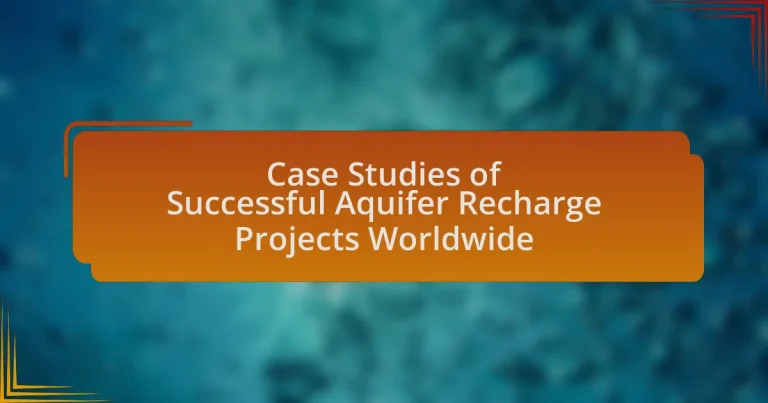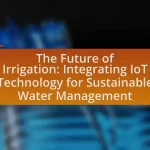Aquifer recharge projects are initiatives aimed at enhancing the natural replenishment of groundwater aquifers by directing surface water into the ground through various methods such as infiltration basins and recharge wells. This article examines successful case studies of aquifer recharge projects worldwide, highlighting their functions, methods, and regional variations. It emphasizes the importance of these projects in improving water availability and quality, mitigating drought impacts, and providing environmental benefits. Additionally, the article discusses best practices for implementation, the role of community engagement, and the challenges faced during project execution, offering insights into effective strategies for sustainable water management.
What are Aquifer Recharge Projects?
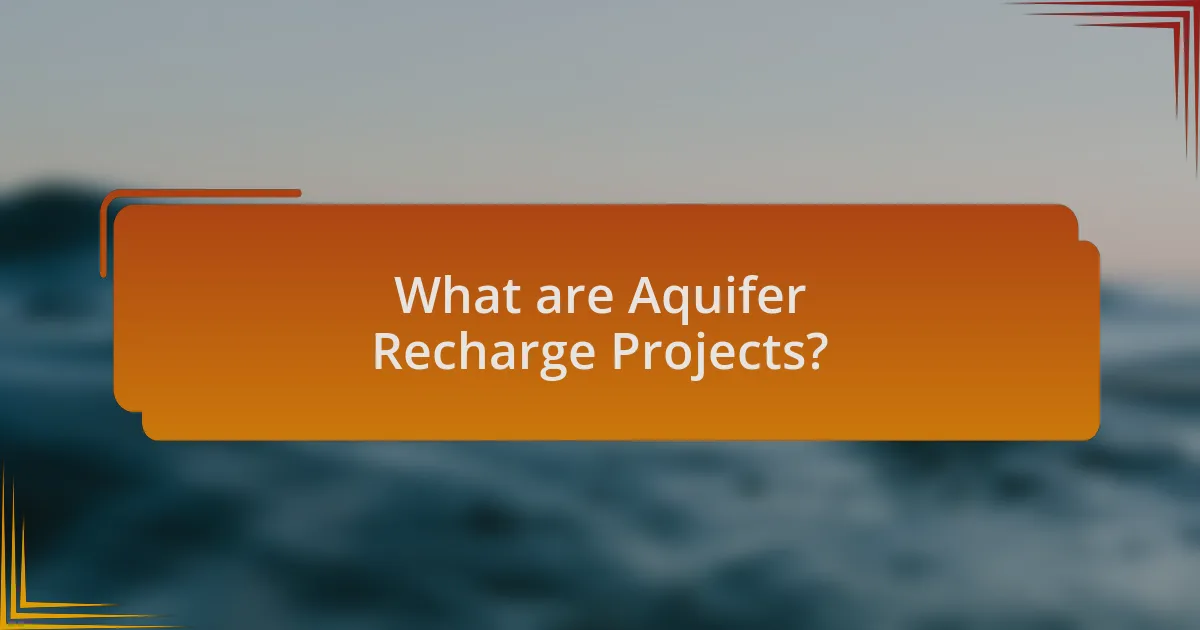
Aquifer recharge projects are initiatives designed to enhance the natural replenishment of groundwater aquifers by directing surface water into the ground. These projects utilize various methods, such as infiltration basins, recharge wells, and stormwater management systems, to facilitate the absorption of water into the aquifer. Evidence of their effectiveness can be seen in regions facing water scarcity, where aquifer recharge has been shown to improve water availability and quality, as demonstrated in successful case studies across the globe.
How do Aquifer Recharge Projects function?
Aquifer recharge projects function by intentionally directing surface water into underground aquifers to replenish groundwater supplies. This process typically involves the construction of recharge basins, infiltration galleries, or wells that allow water to percolate through soil layers and into the aquifer. For example, in California, managed aquifer recharge techniques have been employed to enhance groundwater levels, demonstrating that these projects can effectively increase water availability in arid regions.
What methods are used in Aquifer Recharge Projects?
Aquifer recharge projects utilize several methods, including surface spreading, injection wells, and recharge basins. Surface spreading involves directing water over large areas of land to allow it to percolate into the ground, effectively replenishing the aquifer. Injection wells are used to directly introduce water into the aquifer through boreholes, which can be particularly effective in areas with limited surface infiltration. Recharge basins are designed to capture and store runoff or treated wastewater, allowing it to infiltrate into the ground over time. These methods have been successfully implemented in various regions, demonstrating their effectiveness in enhancing groundwater supplies.
How do these methods vary across different regions?
Aquifer recharge methods vary significantly across different regions due to factors such as climate, geology, and water management practices. For instance, in arid regions like California, managed aquifer recharge often utilizes surface spreading techniques to enhance groundwater levels, while in humid areas like the Midwest, methods may focus on infiltration basins that capitalize on abundant rainfall. Additionally, regions with varying geological formations may employ different technologies; for example, porous limestone aquifers in Florida allow for rapid recharge through well injection, whereas clay-rich areas may require more extensive surface water management to facilitate infiltration. These regional adaptations are essential for optimizing water resource management and ensuring sustainable groundwater supplies.
Why are Aquifer Recharge Projects important?
Aquifer recharge projects are important because they enhance groundwater supplies, improve water quality, and mitigate the impacts of drought. These projects facilitate the natural replenishment of aquifers by capturing surface water and allowing it to percolate into the ground. For instance, studies have shown that managed aquifer recharge can increase groundwater levels by up to 30% in certain regions, significantly contributing to water security. Additionally, these projects can help filter pollutants, leading to cleaner water resources, which is crucial for both human consumption and ecosystem health.
What environmental benefits do Aquifer Recharge Projects provide?
Aquifer Recharge Projects provide significant environmental benefits, including improved water quality, enhanced biodiversity, and increased groundwater levels. These projects facilitate the natural filtration of water as it percolates through soil and rock layers, which helps remove contaminants and pollutants, thus improving the overall quality of groundwater. Additionally, by replenishing aquifers, these projects support ecosystems that depend on groundwater, promoting biodiversity in surrounding habitats. Furthermore, studies have shown that effective aquifer recharge can lead to a rise in groundwater levels, which is crucial for maintaining surface water bodies and mitigating the impacts of droughts.
How do Aquifer Recharge Projects contribute to water sustainability?
Aquifer recharge projects contribute to water sustainability by enhancing groundwater levels and improving water quality. These projects facilitate the natural replenishment of aquifers, which are critical sources of freshwater for drinking, agriculture, and ecosystems. For instance, a study by the United Nations Environment Programme highlights that managed aquifer recharge can increase groundwater storage by up to 30% in arid regions, thereby reducing reliance on surface water sources and mitigating the impacts of drought. Additionally, these projects can filter pollutants, leading to cleaner water supplies, which is essential for sustainable water management.
What are some successful examples of Aquifer Recharge Projects worldwide?
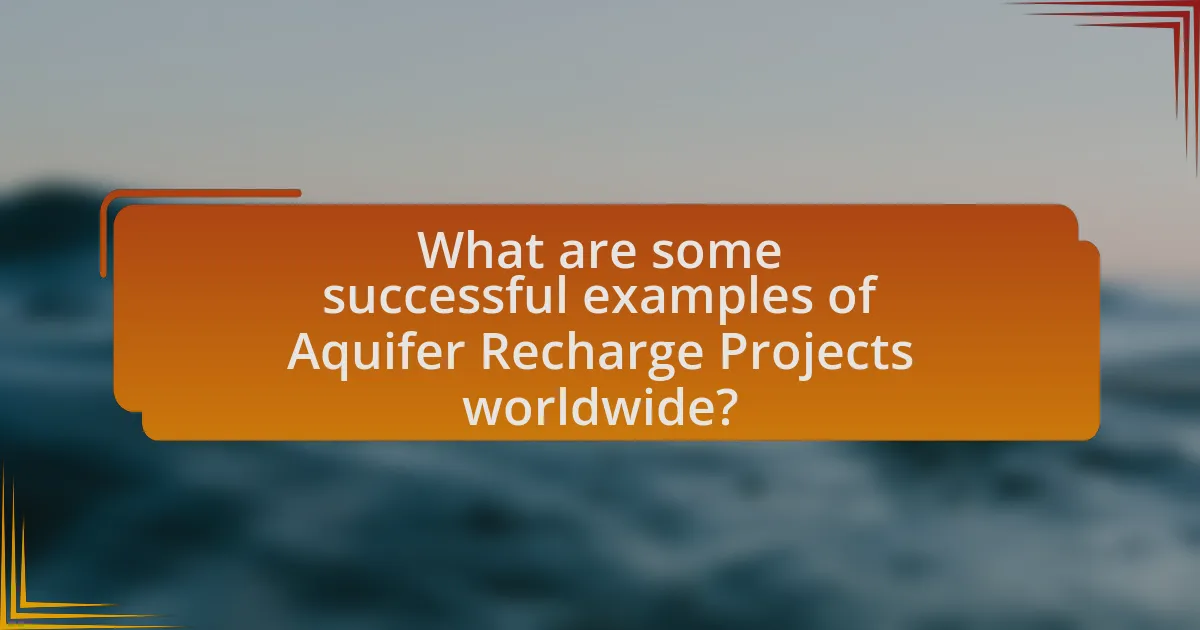
Successful examples of aquifer recharge projects worldwide include the Santa Clara Valley Water District’s groundwater recharge program in California, which has increased groundwater levels by capturing stormwater and treated wastewater. Another notable example is the Managed Aquifer Recharge project in the Netherlands, where excess surface water is intentionally infiltrated into aquifers, improving water quality and availability. Additionally, the City of Phoenix, Arizona, has implemented a robust recharge program that utilizes treated wastewater to replenish the aquifer, resulting in a significant increase in groundwater supplies. These projects demonstrate effective strategies for sustainable water management and aquifer replenishment.
How did the success of these projects come about?
The success of aquifer recharge projects worldwide came about through a combination of effective planning, community involvement, and the use of appropriate technology. Effective planning involved assessing local hydrology and identifying suitable sites for recharge, which ensured that the projects were tailored to specific environmental conditions. Community involvement was crucial, as engaging local stakeholders fostered support and facilitated the implementation of sustainable practices. Additionally, the use of advanced technologies, such as managed aquifer recharge systems and monitoring tools, enhanced the efficiency and effectiveness of water infiltration processes. For instance, the success of the Orange County Water District’s Groundwater Replenishment System in California, which recharges over 100,000 acre-feet of water annually, exemplifies how these factors contribute to project success.
What factors contributed to the success of specific projects?
The success of specific aquifer recharge projects is primarily attributed to effective stakeholder engagement, robust scientific research, and adaptive management practices. Effective stakeholder engagement ensures that local communities, government agencies, and other relevant parties are involved in the planning and implementation phases, which fosters support and collaboration. Robust scientific research provides the necessary data and understanding of hydrogeological conditions, enabling tailored solutions that address specific local challenges. Adaptive management practices allow for ongoing monitoring and adjustments based on performance and environmental changes, ensuring the sustainability and effectiveness of the recharge efforts. These factors collectively enhance project outcomes, as evidenced by successful initiatives in regions like California and Australia, where stakeholder collaboration and scientific assessments led to significant improvements in groundwater levels and water quality.
How do community involvement and stakeholder engagement play a role?
Community involvement and stakeholder engagement are crucial for the success of aquifer recharge projects as they ensure local support and resource sharing. Engaging the community fosters trust and collaboration, which are essential for addressing concerns and incorporating local knowledge into project planning. For instance, the success of the Santa Clara Valley Water District’s aquifer recharge initiatives in California was significantly enhanced by involving local stakeholders, leading to increased public awareness and participation. This collaborative approach not only improves project outcomes but also promotes sustainable water management practices, as evidenced by the positive feedback and active participation from community members in various case studies.
What lessons can be learned from these successful projects?
Successful aquifer recharge projects demonstrate the importance of community involvement and stakeholder engagement. These projects often succeed when local communities are actively involved in the planning and implementation phases, ensuring that the solutions meet their specific needs and garnering public support. For instance, the success of the Managed Aquifer Recharge project in California involved extensive collaboration with local farmers and water agencies, leading to effective water management strategies that benefited all parties involved. Additionally, these projects highlight the necessity of adaptive management practices, allowing for adjustments based on ongoing monitoring and evaluation. The success of the aquifer recharge initiatives in Australia, which utilized real-time data to inform decision-making, exemplifies how adaptive strategies can enhance project outcomes.
What challenges were faced during implementation?
During the implementation of successful aquifer recharge projects worldwide, challenges included technical difficulties, regulatory hurdles, and community engagement issues. Technical difficulties often arose from the need to adapt existing infrastructure to accommodate recharge systems, which required specialized knowledge and resources. Regulatory hurdles involved navigating complex legal frameworks and obtaining necessary permits, which could delay project timelines. Community engagement issues stemmed from the need to gain public support and address concerns about water quality and availability, which were critical for the sustainability of the projects. These challenges highlight the multifaceted nature of implementing aquifer recharge initiatives effectively.
How were these challenges overcome?
Challenges in aquifer recharge projects were overcome through the implementation of innovative technologies, community engagement, and adaptive management strategies. For instance, projects utilized advanced filtration systems to enhance water quality, ensuring that the recharged water met safety standards. Additionally, involving local communities in the planning and execution phases fostered support and compliance, which was crucial for the sustainability of the projects. Adaptive management allowed for ongoing assessment and modification of techniques based on real-time data and feedback, leading to improved outcomes. These approaches have been documented in various successful case studies, demonstrating their effectiveness in addressing specific challenges faced during aquifer recharge initiatives.
What are the best practices for implementing Aquifer Recharge Projects?
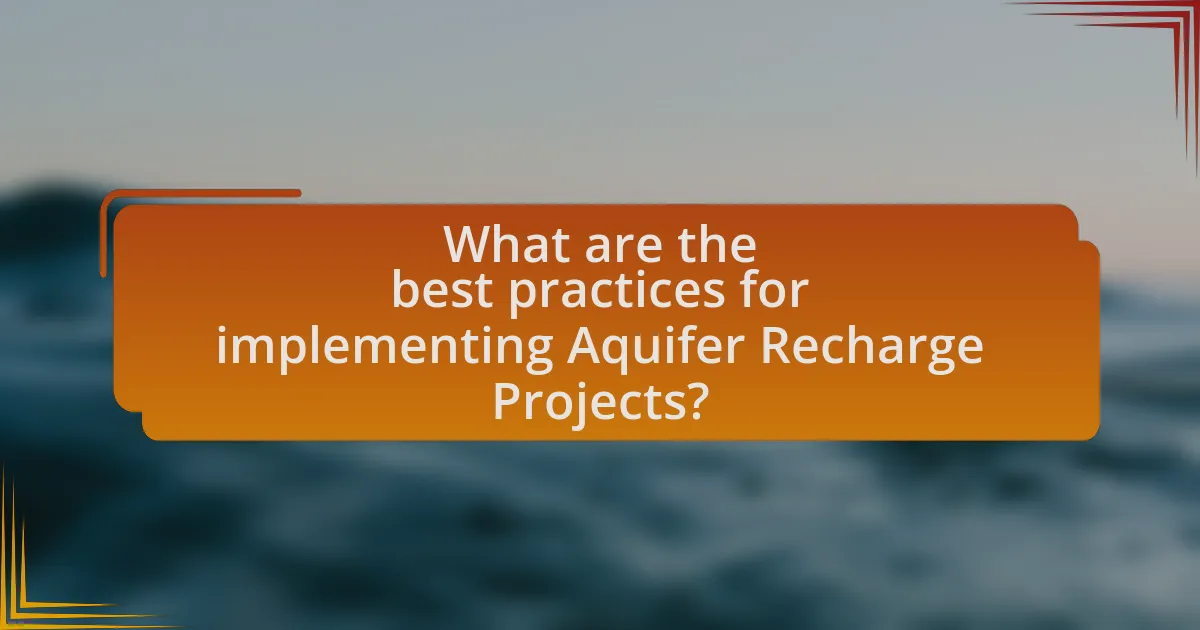
The best practices for implementing Aquifer Recharge Projects include conducting thorough site assessments, selecting appropriate recharge methods, ensuring water quality management, and engaging stakeholders throughout the process. Site assessments involve evaluating geological, hydrological, and environmental conditions to determine the most suitable locations for recharge. Selecting appropriate methods, such as surface spreading, injection wells, or constructed wetlands, is crucial for maximizing recharge efficiency. Water quality management ensures that the water used for recharge meets safety standards to prevent contamination of the aquifer. Engaging stakeholders, including local communities and regulatory agencies, fosters collaboration and support, which is essential for the project’s success. These practices are supported by successful case studies, such as the Santa Clara Valley Water District’s recharge efforts in California, which have demonstrated significant improvements in groundwater levels through systematic implementation of these best practices.
How can stakeholders ensure the success of Aquifer Recharge Projects?
Stakeholders can ensure the success of Aquifer Recharge Projects by actively engaging in comprehensive planning, community involvement, and continuous monitoring. Effective planning involves assessing local hydrology, identifying suitable recharge sites, and integrating scientific research to inform decision-making. Community involvement is crucial, as local stakeholders can provide valuable insights and foster support, which enhances project acceptance and sustainability. Continuous monitoring of water quality and recharge rates allows stakeholders to adapt strategies based on real-time data, ensuring the project meets its objectives. Successful examples, such as the Managed Aquifer Recharge project in California, demonstrate that these practices lead to improved groundwater levels and water quality, validating the effectiveness of stakeholder engagement in aquifer recharge initiatives.
What role does monitoring and evaluation play in project success?
Monitoring and evaluation are critical components that significantly contribute to project success by ensuring that objectives are met and resources are utilized effectively. They provide a systematic approach to assess progress, identify challenges, and make informed decisions throughout the project lifecycle. For instance, in aquifer recharge projects, continuous monitoring of water levels and quality allows project managers to adapt strategies based on real-time data, thereby enhancing the project’s effectiveness. Studies have shown that projects with robust monitoring and evaluation frameworks are 30% more likely to achieve their intended outcomes, demonstrating the importance of these practices in driving project success.
How can adaptive management improve project outcomes?
Adaptive management can improve project outcomes by enabling continuous learning and adjustment based on real-time feedback and changing conditions. This iterative process allows project managers to refine strategies, optimize resource allocation, and enhance decision-making, ultimately leading to more effective and sustainable project results. For instance, in successful aquifer recharge projects, adaptive management has been shown to increase water quality and quantity by allowing stakeholders to respond to environmental changes and stakeholder input, thereby ensuring that the projects remain relevant and effective over time.
What common pitfalls should be avoided in Aquifer Recharge Projects?
Common pitfalls to avoid in aquifer recharge projects include inadequate site assessment, lack of stakeholder engagement, and insufficient monitoring and maintenance. Inadequate site assessment can lead to selecting locations that do not effectively recharge the aquifer, resulting in wasted resources and ineffective projects. Lack of stakeholder engagement often results in community opposition or lack of support, which can hinder project implementation and sustainability. Insufficient monitoring and maintenance can lead to unforeseen issues, such as clogging or contamination, which compromise the effectiveness of the recharge efforts. These pitfalls have been documented in various case studies, highlighting the importance of thorough planning and community involvement for successful aquifer recharge initiatives.
How can inadequate planning impact project effectiveness?
Inadequate planning can significantly diminish project effectiveness by leading to misallocation of resources, unclear objectives, and increased risks. For instance, in aquifer recharge projects, insufficient planning may result in improper site selection, which can compromise water quality and recharge rates. A study by the International Water Management Institute highlights that projects lacking thorough feasibility assessments often face delays and budget overruns, ultimately undermining their intended outcomes. This evidence underscores the critical role of comprehensive planning in ensuring the success of such environmental initiatives.
What are the risks of neglecting community engagement?
Neglecting community engagement in aquifer recharge projects can lead to significant risks, including project failure, community opposition, and loss of trust. When communities are not involved, they may resist initiatives, resulting in delays or halting of projects, as seen in various case studies where local opposition arose due to lack of communication. Additionally, without community input, projects may not address local needs or concerns, leading to ineffective solutions and wasted resources. Historical examples demonstrate that successful aquifer recharge projects often include robust community engagement strategies, which enhance project sustainability and acceptance.
What practical tips can enhance the effectiveness of Aquifer Recharge Projects?
To enhance the effectiveness of Aquifer Recharge Projects, implementing site-specific assessments is crucial. These assessments should evaluate local hydrology, soil characteristics, and land use to determine the most suitable recharge methods. For instance, studies have shown that tailored designs, such as using infiltration basins or recharge wells based on specific geological conditions, significantly improve water capture rates. Additionally, incorporating community engagement in project planning fosters local support and ensures that the recharge methods align with community needs, as evidenced by successful projects in California where stakeholder involvement led to increased project sustainability.
